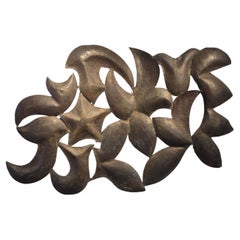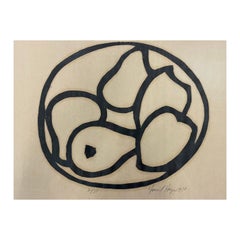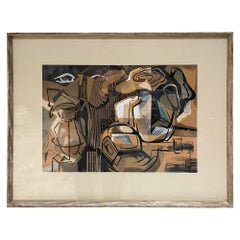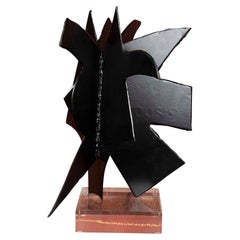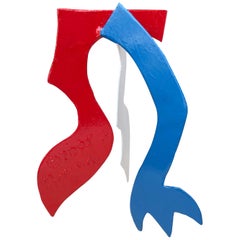Painted, welded steel. Signed and dated 1993.
Over the course of six decades, American modern master David Hayes produced a body of sculptural work that concerned itself with geometrically abstracting organic forms. His monumental outdoor sculptures contemplate the relationship between a work of art and the environment it occupies, and demonstrate the influence of teacher David Smith and friend Alexander Calder.
Born in 1931, Haye’s talent for aesthetics convinced his fifth grade teacher to push him towards a life of art. At 18, Hayes opted to attend college in order to expand his understanding of the creative process. He enrolled at Notre Dame, and upon graduation immediately pursued his masters in fine art from Indiana University. Indiana University had recently elected one of modernism's sculptural leaders, David Smith, as a visiting artist. A powerful figure in the sculpture movement of the 1950s and 1960s, Smith was well known for his unique utilization of industrial materials to construct large scale objects in place of the more historically oriented sculptural processes of casting and carving. This serendipitous appointment proved to be a defining event for Hayes in his artistic development.
Welding Hayes studied attentively under Smith, whose iconic colored steel geometries held an evident influence over Hayes' later body of work. Like Smith, he mastered an appreciation for the permanence of steel. Following his formal studies, Hayes would continue to work with Smith, now his friend, in Bolton Landing, New York.
While living in Indiana, both Smith and Hayes learned about forging from a local blacksmith. Smith began his Forging Series in 1955, while continuing to weld his larger forms and revered Tanktotems. Hayes also adopted the forge, leading to the production of his animal forms series, small- to mid-scale sculptures that harbored allusions to animal figures. A number of these works were exhibited in contemporaneous shows at New York’s Museum of Modern Art and the Guggenheim Museum’s inaugural exhibition in 1959.
Hayes received his MFA in June 1955, and spent the next two years in the Navy. Following his term in the military, Hayes returned to Coventry, Connecticut to return to his forge and welding torch. Over the next few years, Hayes received numerous awards for his work, including the 1961 Logan Prize for Sculpture from the Art Institute of Chicago and an award from the National Institute of Arts and Letters. In 1961 Hayes was awarded both a Fulbright Scholarship for study in Paris and a Guggenheim Fellowship, which conferred an experience that greatly impacted the direction of his future body of work.
Hayes packed his bags and left for Paris in 1961 with his wife, Julia, and their two children. While in Paris, Hayes regularly visited Alexander Calder, one of the most famous figures generated by the American sculptural scene of the mid-20th century, who was also living in central France during this time. Calder, similar to Hayes and Smith, also had begun to produce monumental sculptures out of industrial material in the mid-1950s. It would be remiss to say that Calder's playful shapes and colors affected no passing influence on Hayes' work. In fact, Hayes' combination of flattened shapes feel more in line with Calder's appreciation of the steel form than Smith's more dimensionally oriented geometric towers. More correctly, Hayes' work represents a merger between his two mentors' different interpretations of the physicality of industrial sculpture while still maintaining its own stylistic flair.
In addition to Calder, Hayes also met with Henry Moore in England and Alberto Giacometti in Paris, all the while continuing to forge his own steel body of work, which lead to an aggressive show schedule in Paris and the US.
On returning to the US a decade later, Hayes moved from forged steel to cut steel plate as it permitted him to construct larger objects, a move which resulted in his large
outdoor painted sculpture...
